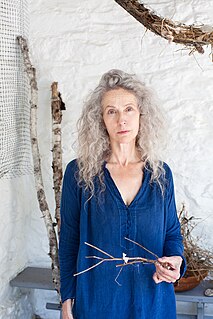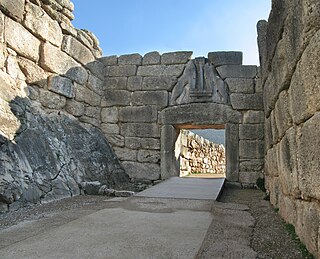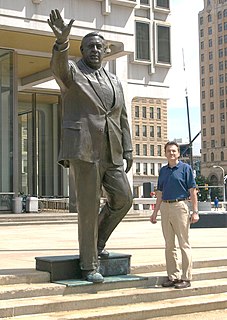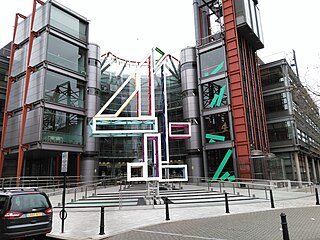Related Research Articles

Sculpture is the branch of the visual arts that operates in three dimensions. It is one of the plastic arts. Durable sculptural processes originally used carving and modelling, in stone, metal, ceramics, wood and other materials but, since Modernism, there has been an almost complete freedom of materials and process. A wide variety of materials may be worked by removal such as carving, assembled by welding or modelling, or molded or cast.

Kiki Smith is a West German-born American artist whose work has addressed the themes of sex, birth and regeneration. Her figurative work of the late 1980s and early 1990s confronted subjects such as AIDS and gender, while recent works have depicted the human condition in relationship to nature. Smith lives and works in the Lower East Side, New York City, and the Hudson Valley, New York State.

Anthony Peter Smith was an American sculptor, visual artist, architectural designer, and a noted theorist on art. He is often cited as a pioneering figure in American Minimalist sculpture.

The Lion Gate was the main entrance of the Bronze Age citadel of Mycenae, southern Greece. It was erected during the 13th century BC, around 1250 BC in the northwest side of the acropolis and is named after the relief sculpture of two lionesses or lions in a heraldic pose that stands above the entrance.

In the Archaic phase of ancient Greek art, the Orientalizing period is the cultural and art historical period which started during the later part of the 8th century BC, when there was a heavy influence from the more advanced art of the Eastern Mediterranean and Ancient Near East. The main sources were Syria and Assyria, and to a lesser extent also Phoenicia and Egypt.

Markus Lüpertz is a German painter, sculptor, graphic artist and writer. He also publishes a magazine, and plays jazz piano. He is one of the best-known German contemporary artists. His subjects are characterized by suggestive power and archaic monumentality. Lüpertz insists on capturing the object of representation with an archetypal statement of his existence. His art work is associated to neo-expressionism. Known for his eccentricity, German press has stylized him as a "painter prince".

Lynn Russell Chadwick, was an English sculptor and artist. Much of his work is semi-abstract sculpture in bronze or steel. His work is in the collections of MoMA in New York, the Tate in London and the Centre Georges Pompidou in Paris.

Zenos Frudakis is an American figurative sculptor whose subjects include portraits of living and historical individuals and poetic/philosophical sculpture. He lives and works near Philadelphia. His works include those at Brookgreen Gardens, the Lotos Club of New York City, the Utsukushi ga-hara Open Air Museum in Japan, the National Academy of Design, and the U.S. Embassy in Pretoria, South Africa

Throwback is a public artwork by American artist Tony Smith, located at the Hirshhorn Museum and Sculpture Garden in Washington, D.C., United States. This version is the third of an edition of three in the series with one artist's proof.

Smog is a public artwork by American artist Tony Smith located to the south east of McCardell Bicentennial Hall on the Middlebury College campus, in Middlebury, Vermont. An example of minimalist sculpture, the piece is a lattice of 45 octahedra, standing on 22 tetrahedra, and topped with 15 prisms. It is fabricated from aluminum, painted black. This work is first in an edition of three, with one artist's proof.
Tau is a public artwork by American artist Tony Smith, located on the urban campus of Hunter College, in New York City, New York, United State of America. Fascinated by mathematics, biology and crystals, Smith designed Tau with geometry at its root.
Smoke is a large-scale sculpture conceived by American artist Tony Smith in 1967 that was fabricated posthumously in 2005 for the Los Angeles County Museum of Art (LACMA) where it was installed in 2008. This two-tier sculptures standing 24 foot tall is made of aluminum and painted black.

Gracehoper is a public artwork by American artist Tony Smith, located in the Louisville Waterfront Park, which is in Louisville, Kentucky. This large-scale sculpture, measuring twenty-two feet high and forty six feet long, was fabricated by Lippincott, Inc in 1988, eight years after Smith's death, at a cost of one million dollars. The sculpture is made of welded steel that has been painted black.
Moses is a series of three different painted steel statues of geometric shapes, created by Tony Smith.

The Big 4 is a sculpture made of steel bars located outside the headquarters of the Channel Four Television Corporation in London. It is designed to represent the logo of Channel 4 while providing a basis for a number of art installations. As of November 2012 seven installations have been made on the statue's steel framework, including those to coincide with the 2012 Summer Paralympics, covered with both newsprint and umbrellas, and a design to simulate the statue breathing. A further dressing to celebrate the devolution of Channel 4 from London to a series of regionally-based offices, alongside the Horseferry Road HQ has recently been approved and will be erected later in 2019.
Moses (3/3) is a public sculpture of the prophet Moses by United States artist Tony Smith. It is on the grounds of the Toledo Museum of Art in Toledo, Ohio. The title of the work was inspired from readings of his own work that links this sculpture to the work of Michelangelo and Rembrandt.
Tau, by American sculptor Tony Smith, was designed in the early 1960s. It is 14’ high x 12’ wide x 12’ deep, and made from black painted steel. Its title refers to the Greek letter 'T', which also describes the shape of the sculpture. Fascinated by mathematics, biology and crystals, Smith designed Tau with geometry at its root. There are two extant versions of the large sculpture: Tau (AP), and Tau (1/3).

Playground is a public artwork by American artist Tony Smith, located at Beverly Gardens Park in Beverly Hills, California. It is a welded steel sculpture surfaced with black paint. The sculpture was conceived in 1962 and cast in 2003. Situated on the edge of Beverly Gardens Park and visible from the street, this sculpture is mounted on an approximately 4” tall concrete platform. It measures 5’ 4” height x 10’ 8” width x 5’ 4” depth.

Light Up, often stylised as Light Up!, is a painted steel plate public art sculpture by American artist Tony Smith and dedicated on May 15, 1974. The sculpture is located in the University of Pittsburgh's Forbes Quadrangle between Posvar Hall, the Barco Law Building, and Hillman Library. Commissioned in 1971 by Westinghouse Electric Corporation, it was originally situated in Gateway Center in downtown Pittsburgh, but was donated to the University of Pittsburgh and relocated to its Oakland campus in 1988. The sculpture was temporarily recited to the Seagram Plaza in New York City in 1998 for an exhibition of Smith's work at the Museum of Modern Art.

Ancient Greek art stands out among that of other ancient cultures for its development of naturalistic but idealized depictions of the human body, in which largely nude male figures were generally the focus of innovation. The rate of stylistic development between about 750 and 300 BC was remarkable by ancient standards, and in surviving works is best seen in sculpture. There were important innovations in painting, which have to be essentially reconstructed due to the lack of original survivals of quality, other than the distinct field of painted pottery.
References
- ↑ Storr, Robert (1998). Tony Smith architect, painter, sculptor ; [Ausstellung] Museum of Modern Art, New York, 2.7.1998 - 22.9.1998. essays by John Keenen. New York: Abrams. p. 129. ISBN 0-87070-072-3.
- ↑ Tony Smith: Not an Object. Not a Monument. Germany: Göttingen : Steidl. 2007. pp. 36–37, 91. ISBN 978-3-86521-313-6.
- ↑ "Trap by Tony Smith". Artnet. Retrieved 28 May 2014.